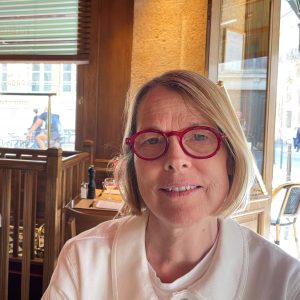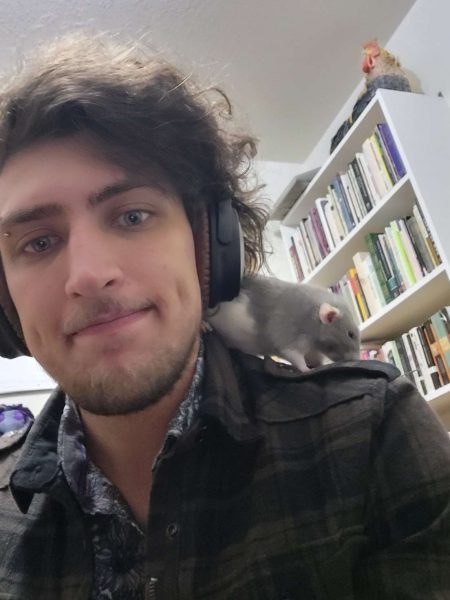Mary Peelen talks the poetry of mathematics, divinity in physics, issues of scale, place, and influence with editorial assistant Kaes Vanderspek.
 Mary Peelen is the author of Quantum Heresies, winner of the Kithara Book Prize. Her poetry, fiction, and nonfiction have appeared in the Massachusetts Review, Michigan Quarterly Review, Harvard Divinity Bulletin, Alaska Quarterly Review, Poetry Daily, Poetry Review (UK), and elsewhere. She lives in San Francisco and Paris.
Mary Peelen is the author of Quantum Heresies, winner of the Kithara Book Prize. Her poetry, fiction, and nonfiction have appeared in the Massachusetts Review, Michigan Quarterly Review, Harvard Divinity Bulletin, Alaska Quarterly Review, Poetry Daily, Poetry Review (UK), and elsewhere. She lives in San Francisco and Paris.
Kaes Vanderspek: I’m interested in how the language of mathematics functions in your poetry. In the popular and modern imagination, poetry and mathematics are often seen as opposite ends of a spectrum. So, I’m curious how you relate to that perceived dichotomy and how it manifests in your work.
Mary Peelen: The very first poem I penned while doing my MFA was a math poem, and for the most part, I’ve kept it up ever since. Math and poetry inform each other, reflect and enhance one another. In my mind, they’re similar, as both are concise expressions of truth that employ symbols, precise language, and a kind of internal logic. Also, they’re both exquisitely beautiful—I think they’re made for each other.
But, you’re right. For most people, math and poetry don’t make for an obvious pairing. I’ve never recognized a contradiction or paradox, though. I experience math and poetry as two different and perfectly legitimate ways of expressing what is meaningful. I don’t see that they have to be understood as a dichotomy, just as the wave/particle duality in physics isn’t really a duality. Light is both particle and wave, a realization that opened up the entire realm of quantum mechanics, which is absolutely monumental. Describing the world as math and poetry can be incredibly revealing, even revolutionary. I suspect that every single thing that’s true can be described in a myriad of ways—using math, poetry, science, religion, music, art. There are other ways of knowing, too, and rather than contradict one other, they can deepen and complicate the nature of truth itself.
Let’s say, for example, you’re describing a peach. With math, you can talk about how many peaches you have, their mass, density, chemical makeup, all with extreme accuracy. Math is indispensable for categorizing the world. Math is ridiculously robust. It’s the language of science, technology, money. But when it comes to emotion and memory, poetry is stronger. Math can’t demonstrate awe, nor craving, nor the summer at Lake Michigan when peach was dripping down my face. I’m always in search of the places where math and poetry intersect, where images take on new dimension, allowing multiple perspectives at once.
I’m no genius at math—but I deeply admire mathematics for its elegance, its universality, its spare, lithe way of conveying patterns that have endless implications in the world. The same equation can apply to the most insignificant microcosm as well as the entire expanding universe. The same can be said of poetry, too. It holds endless implications and repetitions at every single scale.
KV: The way you talk about math makes me think of early mathematicians like Euclid or Pythagoras. They’re very spiritual about it. They don’t see a distinction between math and divinity.
MP: I have always sensed a strong connection between math and divinity. With one symbol— ∞ —mathematics contains the infinite, which is an incredibly efficient way to sum up divinity. Furthermore, math is highly creative in a godlike way, the language for new geometries, new dimensions, sets of infinities, new equations invented every day. And mathematics can be as prescient as any prophet—pure mathematics has predicted countless scientific discoveries long before they were demonstrated experimentally. The secrets of the universe are written in the language of mathematics. As a poet, I feel an urgent need to sit up and take note.
But as Gödel said, at the heart of every logical system there’s an unprovable axiom. That axiom may seem obvious or intuitive, and yet it still defies proof. So in a way, math requires some manner of belief—or at least grudging acceptance—that at the root of every branch of mathematics there is an unprovable kernel of truth, taken on faith. Fundamentally, math and divinity are tied together. Poetry is an amazing way to investigate this deep connection.
KV: It’s never made sense to me to, like you say, limit ourselves to one avenue or perspective for truth or knowing.
MP: I agree. With math, knowledge comes through logic. With religion, one knows things through belief. That’s a way of knowing, too. With poetry and music, it’s aesthetics. They’re all legitimate in their own way. But no single rubric can describe the world completely and objectively, not even science, since even scientists are bound by a particular human perspective. That’s why it makes sense to be open to multiple ways of understanding the world.
KV: Reading your book, Quantum Heresies, I found myself returning again and again to issues of scale. At every turn your work seems to interweave the micro with the macro, the cataclysmic with the supposedly mundane. I’m curious how you imagine these issues of scale at work in your writing.
MP: A couple months ago I had to see a doctor because I had a hemorrhage of my temporal vein. At the exam, the doctor shone a bright light deep in my eye, and when she did, I could see the structure of the veins and arteries in my head. An hour later, sitting on a bench, looking up at the trees outside the ophthalmology office, I saw the very same patterns in the tree branches. The similarity was striking. Symmetries in nature occur not just in the eye of a poet but at every scale, microscopic and macro, and this strongly suggests that there are universal patterns. They repeat everywhere and they are incredibly flexible, expandable and contractible, from the tiniest scale to the greatest. Symmetries and repeating patterns in math and in the universe are so awe-inspiring that they find their way into my poems frequently.
The laws of physics exhibit what’s called translational symmetry, meaning that they behave according to the same laws, in the same way, wherever they are, however far away they’re moved. According to Emmy Noether’s theorem, translational symmetry also means the momentum of a system is conserved. I like to imagine this theory applies to poetry, too, where a metaphor can be understood as having “translational symmetry” when it maintains its “momentum” from a notion in the writer’s brain, to the page, and finally into the mind of the reader where it could be as big as a star, big as a galaxy, microcosm to macrocosm in a single symmetric metaphor.
KV: I’m wondering a bit about your process. Your thinking clearly draws a lot from scientific literature and I’m curious what the process of research looks like for you. How does the reading find its way into the writing?
MP: I tend to write what I’m reading. Currently I’m reading about quantum entanglement, planning a trilogy of poems. I’m not a scientist any more than I’m a mathematician. It’s out of pure interest that I read popular science and math books and articles by authors such as Alan Lightman, Carlo Rovelli, Nathalie Wolchover, and James Gleick. I take notes as I go, frequently stopping to think through what I’m reading, imagining what particular material example could represent this equation or that theory. I spend a lot of time pondering metaphors, translating abstraction into words, into poetry.
Before I wrote my poem “Chaos Theory” I didn’t know anything about the theory itself. I learned as I wrote. I had always assumed it meant that all things devolve into chaos. So I was thrilled to discover that I had it all wrong. Actually, in complex systems, there are patterns that arise and repeat, and symmetry and interconnectedness appear to be woven into the fundamental code of the universe. Complex systems are called “chaotic” not because of how they end up, but because of how they begin: the tiniest change at the beginning of an experiment changes everything about how it will evolve. This is the famous butterfly effect, in which the smallest flap of a wing will, in the future, make all the difference in the world. To complete this poem I drew on an accumulation of small details—gravestones and doxologies—that would culminate, finally, into everything.
KV: Lastly, I’ve noticed that your poems seem to be very grounded in a sense of place. I’m wondering how place finds its way into your poetry and what role you think it serves.
MP: Invoking place is literally grounding, of course, and my work can be a bit abstract, tending toward the theoretical, so naming a solid place helps to anchor the poem in the material world. Without this kind of specificity, my poetry risks flying off into pure ether, so I describe the room when I’m writing, I look out the window, I write about where I am. Place also sets the scene, invoking far more than geography: place carries language, social structure, culture, climate, politics. Everything about the way I see the world changes when I move, so if I am to write the truth, I have to write that spatial translation, too. I’m lucky enough to live most of the year in Paris now. I know where to get a coffee for one euro. French is a gorgeous language, even in complaint. Weather spins in from every direction. These things are a function of Paris that couldn’t matter elsewhere. And they completely change what and how I write.
 Kaes Vanderspek is a first-year poetry MFA candidate at Colorado State University, an editorial assistant for the Colorado Review, and a dedicated father to several baby rats.
Kaes Vanderspek is a first-year poetry MFA candidate at Colorado State University, an editorial assistant for the Colorado Review, and a dedicated father to several baby rats.